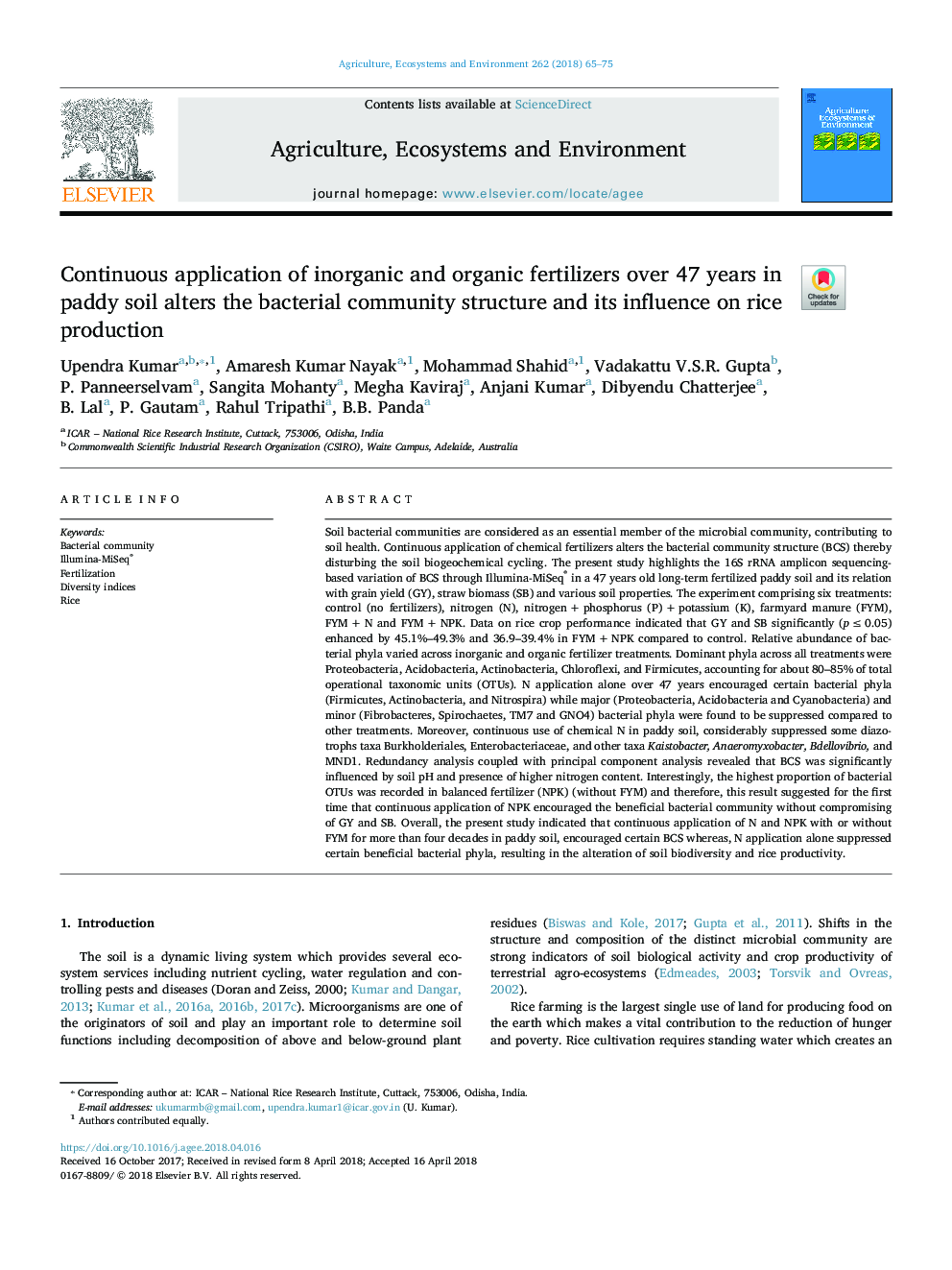| کد مقاله | کد نشریه | سال انتشار | مقاله انگلیسی | نسخه تمام متن |
|---|---|---|---|---|
| 8487048 | 1551990 | 2018 | 11 صفحه PDF | دانلود رایگان |
عنوان انگلیسی مقاله ISI
Continuous application of inorganic and organic fertilizers over 47 years in paddy soil alters the bacterial community structure and its influence on rice production
ترجمه فارسی عنوان
استفاده مداوم از کودهای معدنی و آلی بیش از 47 سال در خاک بذر تغییر ساختار جامعه باکتری ها و تأثیر آن بر تولید برنج
دانلود مقاله + سفارش ترجمه
دانلود مقاله ISI انگلیسی
رایگان برای ایرانیان
کلمات کلیدی
موضوعات مرتبط
علوم زیستی و بیوفناوری
علوم کشاورزی و بیولوژیک
علوم زراعت و اصلاح نباتات
چکیده انگلیسی
Soil bacterial communities are considered as an essential member of the microbial community, contributing to soil health. Continuous application of chemical fertilizers alters the bacterial community structure (BCS) thereby disturbing the soil biogeochemical cycling. The present study highlights the 16S rRNA amplicon sequencing-based variation of BCS through Illumina-MiSeq® in a 47 years old long-term fertilized paddy soil and its relation with grain yield (GY), straw biomass (SB) and various soil properties. The experiment comprising six treatments: control (no fertilizers), nitrogen (N), nitrogenâ¯+â¯phosphorus (P)â¯+â¯potassium (K), farmyard manure (FYM), FYMâ¯+â¯N and FYMâ¯+â¯NPK. Data on rice crop performance indicated that GY and SB significantly (pâ¯â¤â¯0.05) enhanced by 45.1%-49.3% and 36.9-39.4% in FYMâ¯+â¯NPK compared to control. Relative abundance of bacterial phyla varied across inorganic and organic fertilizer treatments. Dominant phyla across all treatments were Proteobacteria, Acidobacteria, Actinobacteria, Chloroflexi, and Firmicutes, accounting for about 80-85% of total operational taxonomic units (OTUs). N application alone over 47 years encouraged certain bacterial phyla (Firmicutes, Actinobacteria, and Nitrospira) while major (Proteobacteria, Acidobacteria and Cyanobacteria) and minor (Fibrobacteres, Spirochaetes, TM7 and GNO4) bacterial phyla were found to be suppressed compared to other treatments. Moreover, continuous use of chemical N in paddy soil, considerably suppressed some diazotrophs taxa Burkholderiales, Enterobacteriaceae, and other taxa Kaistobacter, Anaeromyxobacter, Bdellovibrio, and MND1. Redundancy analysis coupled with principal component analysis revealed that BCS was significantly influenced by soil pH and presence of higher nitrogen content. Interestingly, the highest proportion of bacterial OTUs was recorded in balanced fertilizer (NPK) (without FYM) and therefore, this result suggested for the first time that continuous application of NPK encouraged the beneficial bacterial community without compromising of GY and SB. Overall, the present study indicated that continuous application of N and NPK with or without FYM for more than four decades in paddy soil, encouraged certain BCS whereas, N application alone suppressed certain beneficial bacterial phyla, resulting in the alteration of soil biodiversity and rice productivity.
ناشر
Database: Elsevier - ScienceDirect (ساینس دایرکت)
Journal: Agriculture, Ecosystems & Environment - Volume 262, 15 July 2018, Pages 65-75
Journal: Agriculture, Ecosystems & Environment - Volume 262, 15 July 2018, Pages 65-75
نویسندگان
Upendra Kumar, Amaresh Kumar Nayak, Mohammad Shahid, Vadakattu V.S.R. Gupta, P. Panneerselvam, Sangita Mohanty, Megha Kaviraj, Anjani Kumar, Dibyendu Chatterjee, B. Lal, P. Gautam, Rahul Tripathi, B.B. Panda,
